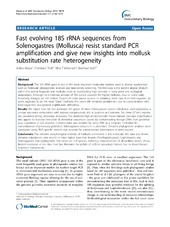| dc.contributor.author | Meyer, Achim | eng |
| dc.contributor.author | Todt, Christiane | eng |
| dc.contributor.author | Mikkelsen, Nina T. | eng |
| dc.contributor.author | Lieb, Bernhard | eng |
| dc.date.accessioned | 2011-01-04T14:44:54Z | |
| dc.date.available | 2011-01-04T14:44:54Z | |
| dc.date.issued | 2010-03-09 | eng |
| dc.Published | BMC Evolutionary Biology 10:70 | en |
| dc.identifier.issn | 1471-2148 | en_US |
| dc.identifier.uri | http://hdl.handle.net/1956/4370 | |
| dc.description.abstract | Background: The 18S rRNA gene is one of the most important molecular markers, used in diverse applications such as molecular phylogenetic analyses and biodiversity screening. The Mollusca is the second largest phylum within the animal kingdom and mollusks show an outstanding high diversity in body plans and ecological adaptations. Although an enormous amount of 18S data is available for higher mollusks, data on some early branching lineages are still limited. Despite of some partial success in obtaining these data from Solenogastres, by some regarded to be the most "basal" mollusks, this taxon still remained problematic due to contamination with food organisms and general amplification difficulties. Results: We report here the first authentic 18S genes of three Solenogastres species (Mollusca), each possessing a unique sequence composition with regions conspicuously rich in guanine and cytosine. For these GC-rich regions we calculated strong secondary structures. The observed high intra-molecular forces hamper standard amplification and appear to increase formation of chimerical sequences caused by contaminating foreign DNAs from potential prey organisms. In our analyses, contamination was avoided by using RNA as a template. Indication for contamination of previously published Solenogastres sequences is presented. Detailed phylogenetic analyses were conducted using RNA specific models that account for compensatory substitutions in stem regions. Conclusions: The extreme morphological diversity of mollusks is mirrored in the molecular 18S data and shows elevated substitution rates mainly in three higher taxa: true limpets (Patellogastropoda), Cephalopoda and Solenogastres. Our phylogenetic tree based on 123 species, including representatives of all mollusk classes, shows limited resolution at the class level but illustrates the pitfalls of artificial groupings formed due to shared biased sequence composition. | en_US |
| dc.language.iso | eng | eng |
| dc.publisher | BioMed Central | en_US |
| dc.rights | Attribution CC BY | eng |
| dc.rights.uri | http://creativecommons.org/licenses/by/2.0 | eng |
| dc.title | Fast evolving 18S rRNA sequences from Solenogastres (Mollusca) resist standard PCR amplification and give new insights into mollusk substitution rate heterogeneity | en_US |
| dc.type | Peer reviewed | |
| dc.type | Journal article | |
| dc.description.version | Published version | en_US |
| dc.rights.holder | Copyright 2010 Meyer et al; licensee BioMed Central Ltd. This is an Open Access article distributed under the terms of the Creative Commons Attribution License (http://creativecommons.org/licenses/by/2.0), which permits unrestricted use, distribution, and reproduction in any medium, provided the original work is properly cited. | en_US |
| dc.identifier.doi | https://doi.org/10.1186/1471-2148-10-70 | |
| dc.identifier.cristin | 348965 | |
| dc.subject.nsi | VDP::Matematikk og Naturvitenskap: 400::Basale biofag: 470::Genetikk og genomikk: 474 | nob |

